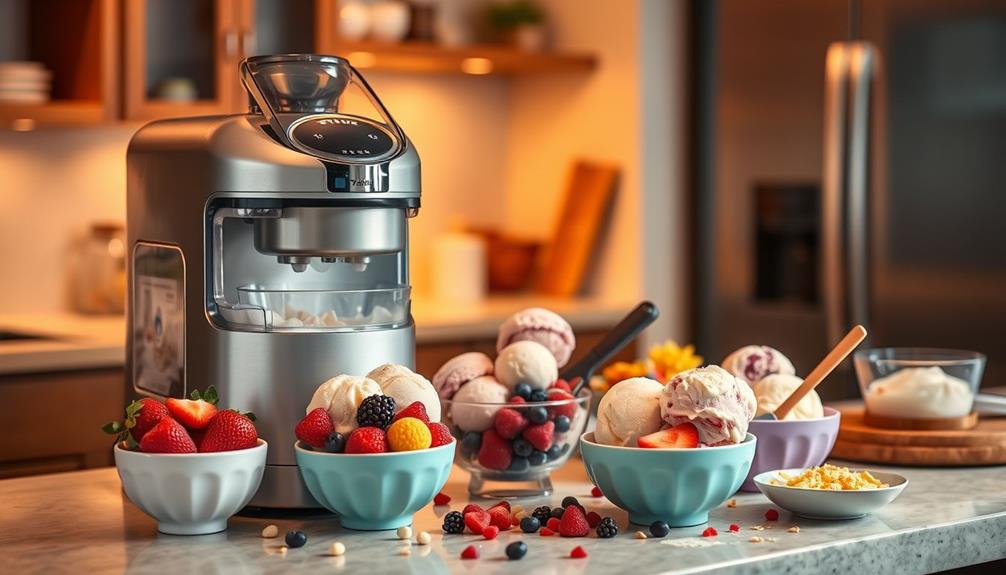Yes, Dairy Queen does have a dairy-free ice cream option. Their Non-Dairy Dilly Bar features a creamy coconut vanilla center that's dipped in chocolate. This treat is vegan-certified and gluten-free, making it a great choice for those with dietary restrictions. You can find it at participating locations, either individually or in boxes of six. Additionally, Dairy Queen offers other dairy-free items like Starkiss popsicles and French fries. If you want to know more about their full range of dairy-free options, you won't want to miss the details ahead.
Key Takeaways
- Dairy Queen offers a Non-Dairy Dilly Bar, featuring a coconut vanilla center dipped in chocolate, which is vegan-certified and gluten-free.
- The Non-Dairy Dilly Bar is the primary dairy-free ice cream option available at Dairy Queen locations.
- Dairy Queen's menu includes other dairy-free items like Starkiss Popsicles and French Fries (without queso).
- Customers should verify potential cross-contamination when ordering dairy-free options at Dairy Queen.
- Using the DQ app, customers can check local availability of the Non-Dairy Dilly Bar.
Dairy Queen's Non-Dairy Options
Dairy Queen has made strides in offering non-dairy options, making it easier for those with dietary restrictions to enjoy a treat. One standout item on their dairy-free menu is the Non-Dairy Dilly Bar, which features a creamy coconut vanilla center dipped in chocolate. This delicious bar not only satisfies your sweet tooth but is also gluten-free and vegan-certified, allowing you to indulge without worry.
Many popular desserts, like ice cream, often contain non-vegan ingredients such as milk or eggs, so it's invigorating to see vegan-friendly alternatives becoming more available.
Launched nationwide in April 2020, the Non-Dairy Dilly Bar represents a significant step for Dairy Queen in catering to customers seeking vegan options. While you won't find traditional dairy-free ice cream at Dairy Queen, this innovative treat provides a satisfying alternative. You can grab a single Non-Dairy Dilly Bar or opt for a box of six at participating locations.
Dairy Queen's commitment to expanding its dairy-free menu means you're no longer left out when everyone else is enjoying a sweet treat.
Understanding Dairy-Free Products

When exploring dairy-free products, it's vital to understand what qualifies as dairy-free and how to identify suitable options. Many people seek out vegan and non-dairy ice cream alternatives, but not all products meet these criteria.
At Dairy Queen, traditional ice cream is dairy-based, but they do offer a few options that cater to those with dairy restrictions. Embracing these dietary changes can lead to a deeper understanding of personal preferences and health needs, serving as a catalyst for heartbreak and healing in one's dietary journey.
Here are some key points to take into account when choosing dairy-free products:
- Ingredients: Check the ingredient list for dairy derivatives, such as milk or cream.
- Cross-Contamination: Inquire about the risk of cross-contamination, especially in restaurants like Dairy Queen.
- Certifications: Look for vegan or dairy-free certifications on packaging.
- Specific Products: Be aware that Dairy Queen's Non-Dairy Dilly Bar is a chocolate-dipped treat with a coconut vanilla cream center, making it a great option for those avoiding dairy.
While Dairy Queen doesn't offer traditional non-dairy ice cream, the Non-Dairy Dilly Bar and other items like Starkiss Popsicles provide tasty alternatives.
Always double-check allergen information to guarantee you're making safe choices.
Flavor Profiles of Dairy-Free Treats

When you try Dairy Queen's Non-Dairy Dilly Bar, you'll immediately notice the creamy coconut flavor that makes it stand out.
This delectable treat is a wonderful addition to the growing market of creamy plant-based ice cream options, catering to those seeking dairy-free alternatives. Its rich, smooth texture rivals traditional dairy ice creams, making it a favorite among vegans, individuals with lactose sensitivities, and even those simply looking to indulge in a healthier dessert option. As the demand for dairy-free alternatives grows, well-known brands are expanding their offerings, such as the dairyfree alternatives at Cold Stone, ensuring that everyone can enjoy a frozen treat without compromise.
The indulgent chocolate coating adds a rich layer of sweetness, enhancing your dessert experience.
Together, these elements create a delicious treat that's perfect for any occasion.
Creamy Coconut Flavor
Indulging in a treat that captures the essence of creamy coconut can be a delightful experience, especially with Dairy Queen's Non-Dairy Dilly Bar. This dairy-free ice cream offers a luxurious coconut vanilla cream center that's both rich and satisfying, making it an excellent choice for those avoiding dairy.
Imagine the joy of savoring a frozen dessert that combines:
- Smooth coconut cream-based protein for a sweet, creamy taste
- A blissful, dairy-free option that's gluten-free and certified vegan
- A delightful treat that feels like a frozen paradise
- A perfect balance of flavors that satisfies your cravings
The Non-Dairy Dilly Bar is crafted to deliver an indulgent experience without the guilt, ensuring everyone can enjoy a taste of paradise.
Whether you're vegan, lactose intolerant, or simply looking to try something new, this coconut treat from Dairy Queen checks all the boxes.
Indulgent Chocolate Coating
The experience of biting into Dairy Queen's Non-Dairy Dilly Bar is elevated by its indulgent chocolate coating, which adds a layer of richness to the creamy coconut vanilla center. This delightful treat isn't just about taste; it's crafted to cater to various dietary needs while delivering a satisfying dessert experience.
| Feature | Details | Benefits |
|---|---|---|
| Base Flavor | Creamy Coconut Vanilla | Rich, creamy texture |
| Coating | Indulgent Chocolate Coating | Sweetness with crunch |
| Calories | 240 | Guilt-free indulgence |
| Dietary Options | Gluten-free, Plant-based | Inclusive for many diets |
| Overall Experience | Dairy-free Delight | Mimics traditional ice cream |
With every bite, the chocolate coating enhances the sweetness, creating a perfect balance with the coconut. You'll appreciate the satisfying crunch that complements the smoothness of the Non-Dairy Dilly Bar. It's a blissful option for those seeking a dairy-free treat that doesn't compromise on flavor. Enjoying this indulgent dessert means you can treat yourself without any dairy worries!
Popular Dairy-Free Menu Items

Dairy Queen's menu includes some exciting dairy-free options that satisfy sweet cravings without compromising dietary needs. While traditional dairy-free ice cream isn't available, you can indulge in the delightful Non-Dairy Dilly Bar. This treat features a creamy coconut vanilla center coated in rich chocolate, and it's both vegan and gluten-free.
It's a fantastic way to enjoy a sweet dessert while sticking to your dietary preferences.
Here are some popular dairy-free menu items you can enjoy at Dairy Queen:
- Non-Dairy Dilly Bar – A creamy coconut vanilla center with a chocolate coating.
- Starkiss Popsicles – Invigorating tri-flavored popsicles in cherry, watermelon, and blue-raspberry.
- French Fries – Crispy and satisfying, perfect as a snack or side.
- Pretzel Sticks – Delicious on their own, just skip the queso for a dairy-free option.
Additionally, you'll find side salads that make for great dairy-free snacks.
While Dairy Queen doesn't currently offer dairy-free ice cream cakes or Blizzard options, these selections make it easier for you to enjoy a treat without the worry of dairy.
Availability and Ordering Process

When you're ready to satisfy your sweet tooth with Dairy Queen's dairy-free options, knowing how to find and order them makes all the difference. While Dairy Queen doesn't offer traditional dairy-free ice cream, you can indulge in the Non-Dairy Dilly Bar, made with coconut cream. This sweet treat is available at participating DQ locations, so be sure to check if your nearest spot carries it.
To make ordering easier, consider using the DQ app. It allows you to check local availability and place orders conveniently. The Non-Dairy Dilly Bar comes individually or in boxes of six, perfect for sharing or treating yourself!
Here's a quick reference to help you navigate your options:
| Item | Details |
|---|---|
| Non-Dairy Dilly Bar | Dairy-free, gluten-free, plant-based |
| Availability | At participating DQ locations |
| Ordering Options | Individual or box of six |
| Cross-Contamination | Check with staff at your location |
Remember to verify with the staff about cross-contamination, as some items are prepared in shared facilities. Enjoy your dairy-free delight!
Complementary Snacks and Sides

Looking to round out your dairy-free treat? Dairy Queen has some great complementary snacks and sides that can elevate your experience. You can enjoy a satisfying meal alongside your Non-Dairy Dilly Bar, which is made with coconut cream and coated in chocolate.
Here are some tasty options that'll keep your dairy-free diet on track:
- French fries (just skip the queso!)
- Hash browns
- Pretzel sticks (hold the butter)
- Side salad (check for cross-contamination)
For an extra flavor kick, pair your fries or chicken strips with dairy-free dipping sauces like BBQ or ketchup.
Remember, menu items can vary by location, so it's a good idea to confirm the availability of these dairy-free options with the staff when you order.
With these snacks, you can create a delicious, dairy-free meal that perfectly complements your sweet treat!
Community Feedback and Engagement

Engagement with the community is essential for Dairy Queen as it endeavors to enhance its menu offerings, including dairy-free options. By actively encouraging community feedback, Dairy Queen invites you to share your thoughts through surveys sent to DQ App users. This open line of communication allows you to express your requests for dairy-free options directly to local managers, fostering a dialogue about possible menu improvements.
Dairy Queen also connects with its audience on social media platforms, making it easy for you to suggest ideas and insights regarding menu options, including vegan and dairy-free items. This level of engagement is vital because it helps the company understand customer needs more effectively.
Moreover, positive experiences shared by users who've found dairy-free choices highlight the growing importance of customer feedback in shaping menu offerings.
Dairy Queen's commitment to community involvement, reflected in its support of initiatives like the Children's Miracle Network, further demonstrates its responsiveness to what you and other customers want. This ongoing interaction strengthens the bond between Dairy Queen and its community, ensuring that everyone's dietary preferences are considered as the menu evolves.
Advocacy for Dairy-Free Offerings

As consumers increasingly seek plant-based alternatives, Dairy Queen has stepped up its advocacy for dairy-free offerings. The introduction of the Non-Dairy Dilly Bar in April 2020 marked a significant milestone in their menu evolution, catering to the rising demand for dairy-free desserts. This delicious treat features a coconut cream center and is both wheat and gluten-free, making it an appealing choice for many.
Dairy Queen's advocacy is further bolstered by petitions from organizations like PETA, reflecting your growing interest in dairy-free options.
Here's what you can expect from Dairy Queen's push for more plant-based alternatives:
- The Non-Dairy Dilly Bar adds variety to your dessert choices.
- Community feedback is actively encouraged, allowing you to voice your preferences.
- There's a hope for future dairy-free innovations, like dairy-free Blizzards.
- The demand for vegan options is being taken seriously by the brand.
With these efforts, Dairy Queen is clearly committed to expanding its dairy-free offerings, ensuring you have more delicious options to enjoy.
Your feedback can help shape the future of their menu, so don't hesitate to speak up!
Historical Context of Dairy-Free Options

In April 2020, Dairy Queen took a significant step by launching the Non-Dairy Dilly Bar, responding to an increasing demand for dairy-free options.
This move came alongside a broader industry trend where fast-food chains began expanding their vegan menu offerings.
Understanding this historical context helps you see how consumer preferences have shaped Dairy Queen's menu and the fast-food landscape.
Launch of Non-Dairy Dilly Bar
Expanding its menu to include the Non-Dairy Dilly Bar in April 2020 marked a significant milestone for Dairy Queen, showcasing the brand's commitment to catering to diverse dietary needs.
This delicious treat features a coconut vanilla cream center, coated in chocolate, making it a tempting dairy-free option for anyone avoiding traditional ice cream.
Here's what you can expect with the Non-Dairy Dilly Bar:
- Certified Vegan: Perfect for those following a plant-based diet.
- Gluten-Free: Suitable for individuals with gluten sensitivities.
- Rich Flavor: The combination of coconut and chocolate offers a delightful taste experience.
- Timely Launch: Introduced during shelter-in-place orders, reflecting the growing demand for non-dairy options.
The introduction of the Non-Dairy Dilly Bar not only emphasizes Dairy Queen's response to changing consumer preferences but also aligns with advocacy efforts for more dairy-free options.
As you savor this treat, you can appreciate the way Dairy Queen is evolving its menu, paving the way for potential future additions, like dairy-free Blizzards.
Growing Vegan Menu Options
The growing demand for vegan menu options has reshaped the fast-food landscape, with Dairy Queen leading the charge in embracing dairy-free alternatives. In April 2020, Dairy Queen launched its Non-Dairy Dilly Bar, a coconut cream-based treat coated in chocolate, marking a significant step toward expanding dairy-free desserts. This move reflects a broader awareness of plant-based diets among consumers, who are increasingly seeking dairy-free options.
Here's a glimpse of Dairy Queen's evolving offerings:
| Dairy Queen Treats | Features |
|---|---|
| Non-Dairy Dilly Bar | Coconut cream center, chocolate coating |
| Future Prospects | Hope for dairy-free Blizzards |
| Consumer Demand | Rising interest in vegan options |
| Advocacy Impact | Support from organizations like PETA |
The introduction of the Non-Dairy Dilly Bar showcases Dairy Queen's commitment to meeting the needs of a diverse customer base. As the vegan market continues to grow, it's exciting to think about what other dairy-free desserts might be on the horizon. With ongoing advocacy and consumer interest, Dairy Queen is poised to expand its vegan menu options even further.
Industry Trends and Awareness
As consumers have shifted their preferences toward plant-based diets, the fast-food industry has stepped up to meet this growing demand for dairy-free options. One notable example is Dairy Queen's introduction of the Non-Dairy Dilly Bar in April 2020, which features a coconut cream base. This move aligns with the broader trend of fast-food chains expanding their vegan menus to accommodate dietary restrictions.
Here are some key trends in this industry:
- Increased awareness of veganism and dietary preferences among consumers.
- Advocacy from organizations like PETA influencing menu changes.
- A gradual rise in plant-based options across various fast-food chains.
- Limited offerings at Dairy Queen, with the Non-Dairy Dilly Bar being one of the few dessert options.
While the Dairy Queen website highlights the Non-Dairy Dilly Bar, it's crucial to recognize that they currently don't offer a dairy-free ice cream option or Blizzards.
This limitation reflects the ongoing evolution within the fast-food sector, as chains adapt to the growing demand for diverse and inclusive menu items. As awareness continues to rise, you can expect more shifts in the availability of dairy-free desserts in the future.
Interesting Facts About Dairy Queen

Dairy Queen has a rich history that many fans mightn't know about. Founded in 1940 in Joliet, Illinois, it has since expanded to over 6,000 locations worldwide. You might be surprised to learn that Dairy Queen is owned by Berkshire Hathaway, and it's famous for its soft serve ice cream, classified as reduced-fat ice cream due to its 5% butterfat content.
In 1953, the first Canadian Dairy Queen opened in Estevan, Saskatchewan, marking the brand's expansion beyond the U.S. This international growth highlights how beloved Dairy Queens are across borders.
In response to growing consumer demand for dairy-free options, Dairy Queen introduced the Non-Dairy Dilly Bar in April 2020, allowing more fans to enjoy their treats.
And if you think size matters, consider that the largest Dairy Queen Blizzard ever created weighed an astonishing 8,224.85 lbs in Springfield, MA! This fun fact showcases the brand's creative marketing and engagement with the community.
Frequently Asked Questions
Can Vegans Eat Dairy Queen Ice Cream?
If you're vegan, you can't eat Dairy Queen's ice cream, since it contains dairy. However, you can enjoy the Non-Dairy Dilly Bar, which is made from coconut cream and is both vegan and gluten-free.
Is Soft Serve Dairy Free?
You might think soft serve could be dairy-free, but it's not. Most options contain dairy, so if you're avoiding it, you'll need to explore other treats—like the Non-Dairy Dilly Bar for a sweet escape.
What Kind of Ice Cream Is Dairy Free?
When you're looking for dairy-free ice cream, consider options made from almond, coconut, or soy milk. These alternatives provide creamy textures and flavors, allowing you to enjoy ice cream without dairy ingredients in your diet.
Is Mcdonalds Ice Cream Dairy Free?
McDonald's ice cream isn't dairy-free; it's made with dairy ingredients. If you're looking for dairy-free options, check with your local McDonald's, but keep in mind they don't typically offer such alternatives on their standard menu.
Conclusion
In a world where indulgence meets inclusivity, Dairy Queen's dairy-free options serve as a rejuvenating oasis for those seeking sweet satisfaction without the dairy. Whether you're savoring a non-dairy Blizzard or a soft-serve treat, you're not just enjoying a dessert; you're embracing a lifestyle that celebrates variety. So, next time you find yourself at Dairy Queen, remember that flavor knows no bounds, and deliciousness is just a scoop away, no matter your dietary needs.









